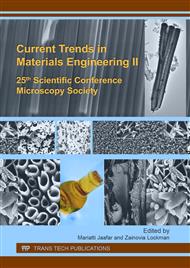[1]
I. Y. A. Fatah, H. P. S. Abdul Khalil, M. S. Hossain, A. A. Aziz, Y. Davoudpour, R. Dungani, and A. Bhat, Exploration of a chemo-mechanical technique for the isolation of nanofibrillated cellulosic fiber from oil palm empty fruit bunch as a reinforcing agent in composites materials, Polymers (Basel)., vol. 6, no. 10, p.2611–2624, (2014).
DOI: 10.3390/polym6102611
Google Scholar
[2]
N. S. Lani, N. Ngadi, A. Johari, and M. Jusoh, Isolation , Characterization , and Application of Nanocellulose from Oil Palm Empty Fruit Bunch Fiber as Nanocomposites, J. Nanomater., vol. 2014, (2014).
DOI: 10.1155/2014/702538
Google Scholar
[3]
Z. Man, N. Muhammad, A. Sarwono, M. A. Bustam, M. Vignesh Kumar, and S. Rafiq, Preparation of Cellulose Nanocrystals Using an Ionic Liquid., J. Polym. Environ., vol. 19, p.726–731, (2011).
DOI: 10.1007/s10924-011-0323-3
Google Scholar
[4]
Y. T. Xiao, W. L. Chin, and S. B. Abd Hamid, Facile Preparation of Highly Crystalline Nanocellulose by Using Ionic Liquid, Adv. Mater. Res., vol. 1087, p.106–110, (2015).
DOI: 10.4028/www.scientific.net/amr.1087.106
Google Scholar
[5]
W. T. Wulandari, A. Rochliadi, and I. M. Arcana, Nanocellulose prepared by acid hydrolysis of isolated cellulose from sugarcane bagasse, IOP Conf. Ser. Mater. Sci. Eng., vol. 107, no. 1, p.12045, (2016).
DOI: 10.1088/1757-899x/107/1/012045
Google Scholar
[6]
L. Segal, J. J. Creely, a. E. Martin, and C. M. Conrad, An Empirical Method for Estimating the Degree of Crystallinity of Native Cellulose Using the X-Ray Diffractometer, Text. Res. J., vol. 29, no. 10, p.786–794, (1959).
DOI: 10.1177/004051755902901003
Google Scholar
[7]
B. A. W. Muhammad Shahid Nazir, A. W. Yussof, and M. A. Abdullah, Eco-Friendly Extraction and Characterization of Cellulose from Oil Palm Empty Fruit Bunches, BioResources, vol. 8, no. 2, p.2161–2172, (2013).
DOI: 10.15376/biores.8.2.2161-2172
Google Scholar
[8]
B. Shanmugarajah, P. Loo, I. Mei, L. Chew, S. Yaw, and K. W. Tan, Isolation of NanoCrystalline Cellulose ( NCC ) from Palm Oil Empty Fruit Bunch (EFB): Preliminary Result on FTIR and DLS Analysis, Chem. Eng. Trans., vol. 45, p.1705–1710, (2015).
Google Scholar
[9]
C. K. Saurabh, R. Dungani, A. F. Owolabi, N. S. Atiqah, A. Zaidon, N. A. S. Aprilia, Z. M. Sarker, and H. P. S. Abdul Khalil, Effect of Hydrolysis Treatment on Cellulose Nanowhiskers from Oil Palm (Elaeis guineesis) Fronds: Morphology, Chemical, Crystallinity, and Thermal Characteristics Chaturbhuj, BioResources, vol. 11, no. 3, p.6742–6755, (2016).
DOI: 10.15376/biores.11.3.6742-6755
Google Scholar
[10]
F. Fahma, S. Iwamoto, N. Hori, T. Iwata, and A. Takemura, Isolation, preparation, and characterization of nanofibers from oil palm empty-fruit-bunch (OPEFB), Cellulose, vol. 17, no. 5, p.977–985, (2010).
DOI: 10.1007/s10570-010-9436-4
Google Scholar


